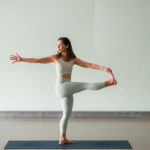
“Asana is a steady, comfortable posture.” – Sri Swami Satchidananda
Asana is the third stage or limb of the eight-limb yoga or Ashtanga Yoga. It is harmony with the body and usually refers to the postures one creates with their breathing, eating, feeling body.
In Sanskrit, sthira sukham asanam, translated to asana, is a steady, comfortable posture. Other variations translate the sutra as a stable, motionless, ease-filled, meditative posture. Simply achieving one posture is enough. However, even in the most comfortable posture you can imagine, there is usually tossing and turning, moving, and cramping. Thus, a comfortable posture is not always easily attained. Muscles need the strength to support the body but also the flexibility to move. Having only muscles leaves you feel stiff, and stiffness breaks. Optimally, we want to be supple yet strong.
Asana is the dichotomy of strength and suppleness in order to meditate with fewer distractions from the body. Sri Swami Satchidananda explained, “What we need is the strength of steel but with steel’s flexibility – not like crude iron, which is very strong and hard but breaks. The body must be so supple it can bend any way you want it to. Such a body will always be healthy and tension-free. The moment we sit down for meditation in such a body, we’ll forget it.”
Moving through yoga postures is simply a way to prepare the body to meditate. Rolf Gates and Katrina Kenison describe asana as the “work you do on the mat” and as a preparation for meditation or simply for physical health. They also mention how asana can be an end in itself, allowing for the postures to be meditative within themselves. The beauty of asana is it can aid in a meditative practice as well as BE the meditative practice.
New yogis will experience various sensations and emotions regarding asana. They may try a pose they have never been in and feel unstable. Perhaps they nail a pose and strive, ambitiously, to “get more postures.” The same yogis can even get disillusioned when it feels as though the practice has stalled with attaining new postures or as the postures begin to need fine tuning. Each individual’s reaction to working through postures can be a mirror to how one approaches life. Unfortunately, our society’s attention is focused on results. Instagram-famous yogis post pictures of difficult yoga poses, and it draws our attention. However, the viewer is not necessarily aware of the time and years of practice needed to achieve the posture. That is what is most important: the process of showing up to your asana practice.
It is easier to still the body than it is to still the mind. By bringing steadiness to a yoga practice, we in essence practice a way to quiet the mind. There may be some shifting and moving into a posture, as is part of the asana practice, but once you find the steadiness in the posture, maintain the connection and allow your breath to become the focus. Although the posture feels still, it is always moving, shifting and changing, just like life. Let each posture and each transition be an opportunity to practice the delicate balance between effort and ease.


